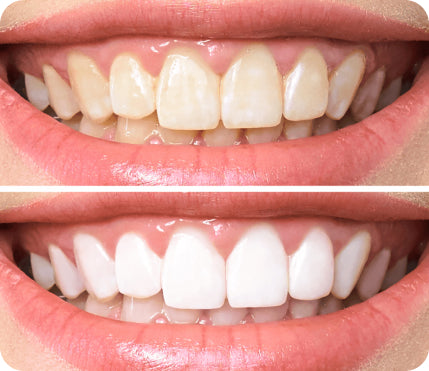
All products are certified by dental expert Dr. Greg Grillo
Are you on a quest for that perfect, dazzling smile? If so, you're likely considering teeth whitening as a means to achieve those coveted pearly whites.
But how often should you whiten your teeth to ensure you maintain a stunning grin without compromising your dental health? In this guide, we'll address all your teeth-whitening questions and concerns.
Below, we’ll delve into the various teeth-whitening methods available, from professional treatments to at-home solutions, and uncover the optimal frequency for each to achieve the best results. Additionally, we'll provide expert tips on how to safely and effectively whiten your teeth, while keeping them healthy and strong. So sit back, relax, and get ready to unlock the secrets to a bright and beautiful smile that will leave a lasting impression!
How Many Teeth Whitening Sessions Do I Need? Determining What's Best For You
Determining the number of teeth whitening sessions you require depends on several factors, including:
- The type of teeth whitening treatment: Differences exist between natural teeth whitening, at-home teeth whitening methods and in-office whitening. For example, in-office treatments administered by professionals generally require fewer sessions and yield faster results than at-home options.
- The severity of your teeth discoloration: The extent of your tooth discoloration, whether arising from years of accumulated stains or resulting from natural aging, affects the number of whitening sessions you'll need. More severe discoloration typically necessitates more sessions.
- The teeth whitening results you wish to achieve: Setting realistic expectations of the desired whitening results plays a critical role in determining the number of whitening sessions required. For individuals seeking modest improvements, fewer sessions might suffice; however, those wishing to significantly brighten their smile usually require additional sessions.
According to one study, more than one-third of Americans are unhappy with their smile, making it crucial to find the right teeth whitening solution for you.
If you carefully consider these factors and consult with a dental professional, you can devise a teeth whitening plan tailored specifically to your unique needs.
Remember that teeth whitening results vary from person to person, and it's vital to manage expectations and adhere to the guidelines provided by dental professionals to prevent over-whitening or causing damage to your teeth.
At-Home Vs. In-Office Teeth Whitening: Differences, Duration, And Effectiveness
Teeth whitening has become increasingly popular as people look for ways to achieve a brighter, more attractive smile. The market offers a variety of at-home teeth whitening and professional treatments to choose from.
However, the number of sessions and the effectiveness of each method can differ significantly. In this section, we will compare at-home and in-office treatments, discuss the duration of each, and provide recommendations for achieving the best results.
At-Home Teeth Whitening Treatments
At-home teeth whitening treatments are often less expensive and more convenient than in-office options. These treatments generally require more sessions to achieve the desired results, as the strength of the whitening agents used is typically lower to ensure teeth whitening safety for unsupervised use. At-home systems contain from 3% to 20% peroxide (carbamide or hydrogen peroxides), which affects the duration and effectiveness of the treatment.
There are various at-home teeth whitening methods available, such as whitening trays, strips, pens, and toothpaste. The number of sessions required and the duration between sessions will vary depending on your individual needs, the specific product, and the strength of the whitening agent. It is essential to consult with your dentist to assess your teeth's level of discoloration and recommend the most effective approach for achieving your desired results.
Be cautious when selecting at-home teeth whitening products, as some may not be as effective or safe as they claim. For example, there is no evidence that shows dental products with charcoal are safe or effective for your teeth. Association.
In-Office Teeth Whitening Treatments
In contrast, professional in-office teeth whitening treatments typically yield faster and more dramatic results, as they often employ higher-strength whitening agents under the supervision of dental professionals. This allows for a more effective treatment, with procedures like Zoom Whitening showing significant results in a single session lasting approximately 45 minutes to an hour.
Even though in-office treatments may require fewer sessions, they can be more expensive and less convenient than at-home options. Ultimately, the choice between at-home and in-office teeth whitening treatments depends on your individual needs, budget, and desired results. Consult with your dentist to determine the best approach for you.
How Long To Wait Between Whitening Sessions
The duration between teeth whitening sessions can vary depending on the treatment method used and your specific needs. For in-office treatments, your dental professional will provide guidelines on how often you can undergo the procedure based on the condition of your teeth, your goals, and the chosen treatment's effectiveness.
For at-home treatments, it is crucial to follow the manufacturer's instructions and consult with your dentist to ensure teeth whitening safety and optimal results. These durations may differ across various treatments, such as whitening trays, strips, or toothpaste. Adhering to the recommended waiting time between sessions helps to prevent potential adverse effects and ensure a more effective outcome.
In conclusion, both at-home and in-office teeth whitening treatments offer their advantages and limitations. By considering your individual dental needs, budget, and preferences, and consulting with your dentist about the best approach, you can work towards achieving a brighter and more confident smile.
How Many Times Should I Whiten My Teeth At Home?
Whitening your teeth at home has become an increasingly popular method for achieving a more attractive, brighter smile in a cost-effective and convenient manner. However, when engaging in this practice, it's crucial to follow each product's specific guidelines to prevent harming your teeth and gums in the process. Overusing whitening products can lead to damage to your tooth enamel and increased sensitivity, causing discomfort and other potential issues.
In most cases, you should limit at-home teeth whitening sessions to once every six months to a year, provided you have already attained your desired level of tooth whiteness. This recommended timeframe may vary, depending on factors such as your diet, personal oral hygiene habits, and the specific whitening product you are using.
Consequences Of Over-Whitening Your Teeth: Understanding The Risks Involved
While many people desire the self-confidence and aesthetic benefits of white teeth, it's crucial to recognize that overdoing teeth whitening can cause a range of problems. Some potential issues associated with excessive teeth whitening include:
- Increased tooth sensitivity: Over-whitening can strip the enamel from your teeth, leading to heightened sensitivity to hot and cold foods and beverages or even just breathing in cold air. This heightened sensitivity can be quite uncomfortable and may potentially lead to other dental issues if not addressed promptly.
- Damaged tooth enamel: Over time, excessive use of whitening products can erode the protective enamel layer on your teeth, which can lead to increased chances of tooth decay and cavities. Damaged enamel may also give your teeth a translucent or blue-ish appearance, which is not aesthetically pleasing.
- Gum irritation and inflammation: Using whitening products too often or incorrectly may cause the harsh chemicals to come into contact with your gums, which can cause irritation or inflammation. This can be particularly problematic if you have pre-existing gum issues, such as gingivitis, as excessive whitening may exacerbate these conditions.
To maintain a healthy, bright smile, it's important to strike a balance between achieving a desirable level of tooth whiteness and protecting your teeth and gums' long-term health. Always follow the product's guidelines and consult with a dental professional for personalized advice on optimal teeth whitening practices. These teeth whitening side effects can be minimized or entirely avoided by strictly adhering to the manufacturer's usage instructions and seeking professional advice from a trusted dentist when necessary. It's always better to prioritize your dental health rather than rushing to achieve a particular aesthetic outcome.
Touch-Ups Versus The First Time Of Full Whitening
Once you've gone through the process and completed a full course of teeth whitening, you'll likely want to maintain that radiant, dazzling smile. To do so, periodic touch-ups are usually needed, as they help keep your teeth looking fresh and vibrant over time.
Touch-ups are not as intensive or as frequent as a first-time full whitening treatment. These maintenance sessions mainly focus on addressing any new staining or discoloration that may have occurred since your last whitening session, as well as revitalizing the existing shade of your teeth.
The frequency and teeth whitening duration of touch-up sessions may vary depending on several factors:
- Your teeth's original color and condition before the initial whitening treatment
- Your desired shade of whiteness and aesthetic preferences
- The specific teeth whitening method utilized (e.g., at-home kits or in-office procedures)
- The quality of your oral hygiene practices and the consistency of your dental care regimen
- Your dietary habits and consumption of teeth-staining foods or drinks (e.g., coffee, tea, wine, and tobacco)
As a general rule of thumb, individuals who maintain good oral hygiene, adhere to a balanced diet, and avoid excessive consumption of staining substances may require touch-ups every 6 to 12 months. However, it's essential to consult with your dentist to determine the most appropriate and effective touch-up schedule suited for your unique dental needs and lifestyle factors.
Should You Whiten Your Teeth Daily?
Whitening your teeth on a daily basis is generally not advisable. Excessive use of teeth whitening products can result in unpleasant side effects such as tooth sensitivity, irritation of the gums, and damage to the tooth enamel. Instead of overusing teeth whitening products, it's essential to adhere to the guidelines provided by the manufacturer or seek advice from a dental professional if you have any doubts or specific concerns regarding teeth whitening.
How Often Should You Whiten Your Teeth With Whitening Strips?
The frequency with which you should use whitening strips is determined by the specific instructions provided by the product manufacturer, as individual products may have varying recommendations. Generally, the proper usage of whitening strips ranges from once every few days to once or twice a week. It is of utmost importance to heed the advised duration of use to minimize the risk of causing damage to your teeth and gums.
How Often Should You Whiten Your Teeth With Toothpaste?
In most cases, whitening toothpaste can be used on a daily basis because these types of toothpaste contain a lower concentration of peroxide when compared to other teeth whitening products. That being said, it remains crucial to follow the recommendations of the toothpaste's manufacturer to achieve the best possible results while preventing any potential issues caused by overuse.
How Long After Zoom Whitening Can I Whiten Again?
Following a Zoom whitening treatment, you should ideally wait for a period of at least six months to a year before considering any further whitening procedures. That being said, your dentist may suggest periodic touch-ups or the use of at-home whitening products in order to maintain the brightness of your smile. It is always a good idea to discuss your personal needs and concerns with your dental professional so that they can help you establish an effective plan for preserving your teeth's whiteness.
The Bottom Line: Weighing The Pros And Cons Of Teeth Whitening
In the quest for a brighter smile, it's crucial to carefully consider the potential benefits and risks associated with teeth whitening. Ensuring that you follow manufacturer instructions, consult with dental professionals, and allow sufficient recovery time between treatments will enable you to safely and effectively improve your smile.
It's important to note that teeth whitening treatments can vary significantly in terms of quality, efficacy, and safety. Thoroughly research your available teeth whitening options and carefully weigh the teeth whitening costs involved. Strive for an approach that strikes an ideal balance between affordability, safety, and effectiveness.
If you decide to try whitening at home, the American Dental Association suggests that you talk with your dentist first, especially if you have certain dental conditions. At-home whiteners have peroxides, typically carbamide peroxide, in amounts ranging from 10% to 20%.
In conclusion, there isn't a one-size-fits-all solution when determining the optimal frequency for teeth whitening. Numerous factors must be considered, such as individual preferences, the specific product or method employed, and professional dental advice.











